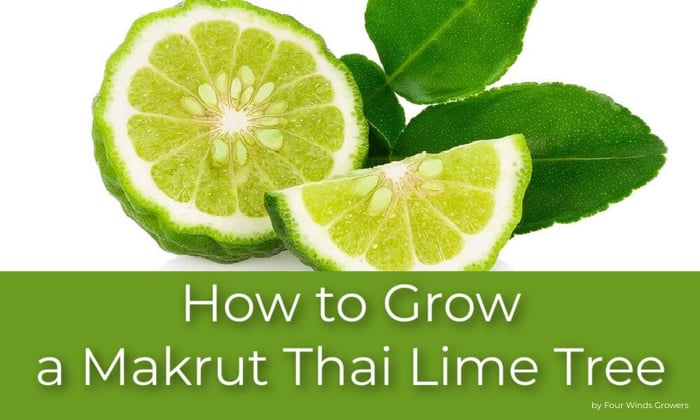Have you always wanted to know how to grow a Makrut Thai Lime tree? They are not difficult to grow! In fact, they are one of the easiest citrus trees to grow. This is because the tree is mostly utilized for its leaves, and so fruit production is not necessarily as important. Thai limes have a fragrant, memorable aroma and high oil content, which lends well to adding tons of flavor to Asian dishes.
Also known as Thai limes, Makrut limes are a citrus fruit typically grown in Southeast Asian countries like Thailand, Indonesia, and Malaysia. They can be grown in US Zones 9-11 in the ground, or US Zones 6-11 in containers. These limes are distinct from classic limes in both appearance and flavor. Makrut limes are small, bumpy-skinned, and typically a rich green color. The leaves of the Makrut lime tree are different from regular lime leaves, in that they have a double-lobed shape. The fruit has a unique and intense citrusy aroma and flavor, with a tart and somewhat bitter taste.
The history of the fruit’s name has been a hot topic among fruit growers. At some point in history and discovery, the variety was labeled as a "Kaffir” Lime. The original reasons for why this fruit was given this name is up for debate, but what is not is that this word is considered offensive in some countries, particularly South Africa, due to its derogatory connotations. "Makrut", the Thai word, is the preferred name for this variety of limes.
Some examples of dishes where Makrut limes are commonly used include: Thai Green Curry, Tom Yum Soup, and making curry paste.
If you want to grow a Makrut Thai Lime tree, there are a few things to consider first. Here are some growing tips:
Choose the Right Location:
Makrut lime trees thrive in warm, tropical, or subtropical climates. They prefer full sun, so select a location that receives at least 6-8 hours of sunlight daily.
Make sure the area has chunky, well-draining soil.
Planting:
If you are planting in a pot or container, choose a large pot with good drainage holes. A starter plant should be planted in a 10-14" container.
Planting in the ground: Plant the lime tree in a prepared area about 3x the diameter of the pot. That soil should be well-draining and loose, allowing for root growth. Plant your tree in a hole twice the size of the root ball and at the same depth of the pot, keeping the crown of the roots just above the soil line. Water thoroughly after planting.
Watering:
Water the tree regularly to keep the soil consistently moist but not waterlogged. Water deeply when the top 2" inches of soil becomes dry.
Adjust the frequency of watering based on the climate. In hot and dry conditions, you may need to water more often. Do not water unless the top 2" of the soil in the pot is dry.
Fertilizing:
Fertilize your Makrut lime tree with a balanced fertilizer, such as Romeo Fertilizer or G&B Organics Citrus and Fruit Tree Fertilizer. Follow the manufacturer's instructions, You should apply fertilizer in the spring and summer, which are the growing months.
Pruning:
Prune your tree to shape it and remove dead or diseased branches. Pruning can help improve air circulation and sunlight exposure for the tree.
Pest and Disease Management:
Keep an eye out for pests like aphids, scale insects, and mealybugs. Treat any infestations promptly using organic or chemical solutions as necessary, such as Captain Jack's Insecticidal Soap.
Harvesting:
Makrut lime trees produce fragrant leaves that are commonly used in cooking. You can harvest leaves as needed. Do not remove more than 25% of the leaves at one time, they are necessary for photosynthesis and the tree's growth.
The fruits can be harvested when they turn green or slightly yellow, usually in late summer or early fall.
Winter Protection for Colder Climates:
In regions with cold winters, consider moving your potted Makrut lime tree indoors or to a protected area during the colder months. These trees are sensitive to frost and cold temperatures.
Patience:
Growing a Makrut lime tree from a young plant to a mature, fruit-bearing tree can take several years, so be patient and consistent in caring for it.
Remember that growing citrus trees can be a long-term commitment, but with proper care, you can enjoy the fragrant leaves and fruits of your Makrut lime tree for years to come.
Also Read: Curry Leaf Tree Growing Guide
$65.00
--OVERVIEW-- There has been some controversy surrounding one of the names of the Makrut lime, Kaffir, as it has derogatory connotations in South African and Middle Eastern cultures, which is why we prefer to simply call them Thai limes.… read moreMakrut (Kieffer/Kaffir) Thai Semi-Dwarf Lime Tree





